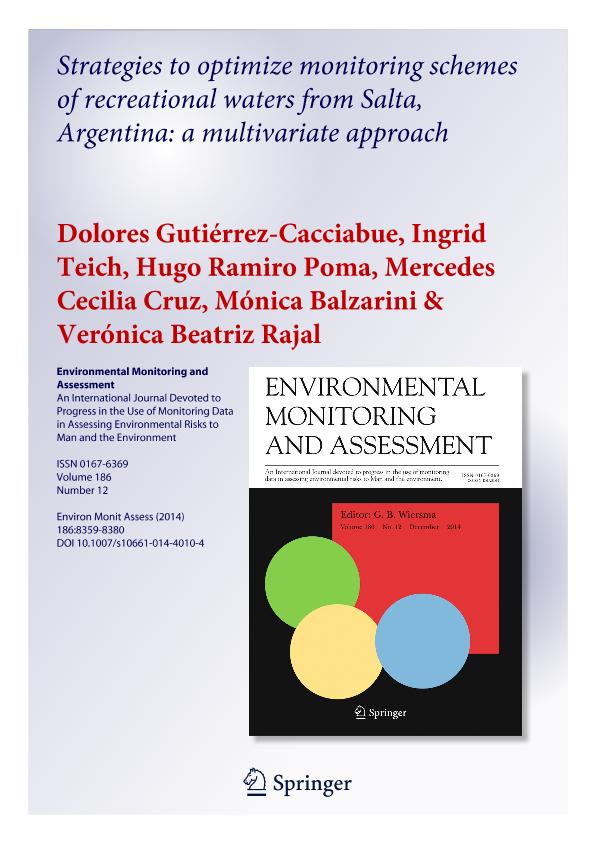Artículo
Strategies to optimize monitoring schemes of recreational waters using a multivariate approach
Gutiérrez Cacciabue, Dolores ; Teich, Ingrid
; Teich, Ingrid ; Poma, Hugo Ramiro
; Poma, Hugo Ramiro ; Cruz, Mercedes Cecilia
; Cruz, Mercedes Cecilia ; Balzarini, Monica Graciela
; Balzarini, Monica Graciela ; Rajal, Verónica Beatriz
; Rajal, Verónica Beatriz
 ; Teich, Ingrid
; Teich, Ingrid ; Poma, Hugo Ramiro
; Poma, Hugo Ramiro ; Cruz, Mercedes Cecilia
; Cruz, Mercedes Cecilia ; Balzarini, Monica Graciela
; Balzarini, Monica Graciela ; Rajal, Verónica Beatriz
; Rajal, Verónica Beatriz
Fecha de publicación:
08/2014
Editorial:
Springer
Revista:
Environmental Monitoring And Assessment
ISSN:
0167-6369
Idioma:
Inglés
Tipo de recurso:
Artículo publicado
Clasificación temática:
Resumen
Several recreational surface waters in Salta, Argentina, were selected to assess their quality. Seventy percent of the measurements exceeded at least one of the limits established by international legislation becoming unsuitable for their use. To interpret results of complex data, multivariate techniques were applied. Arenales River, due to the variability observed in the data, was divided in two: upstream and downstream representing low and high pollution sites, respectively, and cluster analysis supported that differentiation. Arenales River downstream and Campo Alegre Reservoir were the most different environments, and Vaqueros and La Caldera rivers were the most similar. Canonical correlation analysis allowed exploration of correlations between physicochemical and microbiological variables except in both parts of Arenales River, and principal component analysis allowed finding relationships among the nine measured variables in all aquatic environments. Variable?s loadings showed that Arenales River downstream was impacted by industrial and domestic activities, Arenales River upstream was affected by agricultural activities, Campo Alegre Reservoir was disturbed by anthropogenic and ecological effects, and La Caldera and Vaqueros rivers were influenced by recreational activities. Discriminant analysis allowed identification of subgroup of variables responsible for seasonal and spatial variations. Enterococcus, dissolved oxygen, conductivity, E. coli, pH, and fecal coliforms are sufficient to spatially describe the quality of the aquatic environments. Regarding seasonal variations, dissolved oxygen, conductivity, fecal coliforms, and pH can be used to describe water quality during dry season, while dissolved oxygen, conductivity, total coliforms, E. coli, and Enterococcus during wet season. Thus, the use of multivariate techniques allowed optimizing monitoring tasks and minimizing costs involved.
Archivos asociados
Licencia
Identificadores
Colecciones
Articulos(CCT - CORDOBA)
Articulos de CTRO.CIENTIFICO TECNOL.CONICET - CORDOBA
Articulos de CTRO.CIENTIFICO TECNOL.CONICET - CORDOBA
Articulos(INIQUI)
Articulos de INST.DE INVEST.PARA LA INDUSTRIA QUIMICA (I)
Articulos de INST.DE INVEST.PARA LA INDUSTRIA QUIMICA (I)
Citación
Gutiérrez Cacciabue, Dolores; Teich, Ingrid; Poma, Hugo Ramiro; Cruz, Mercedes Cecilia; Balzarini, Monica Graciela; et al.; Strategies to optimize monitoring schemes of recreational waters using a multivariate approach; Springer; Environmental Monitoring And Assessment; 186; 12; 8-2014; 8359-8380
Compartir
Altmétricas



